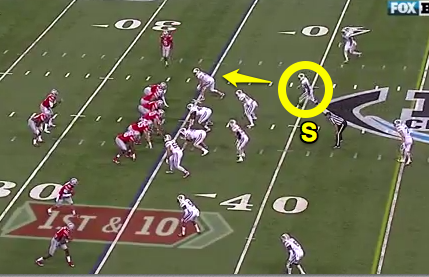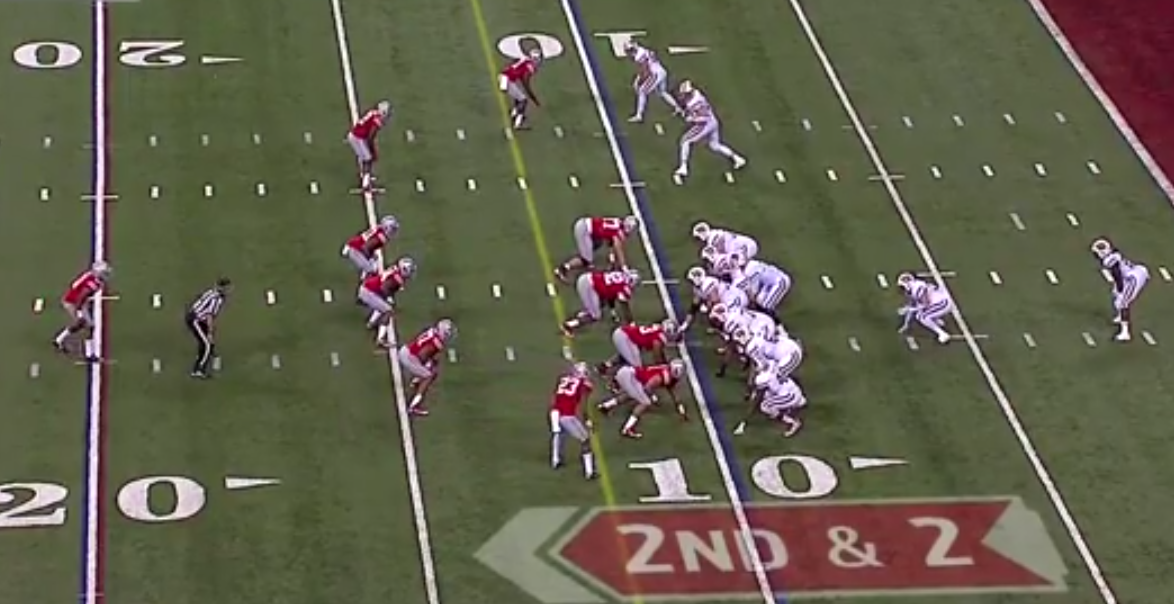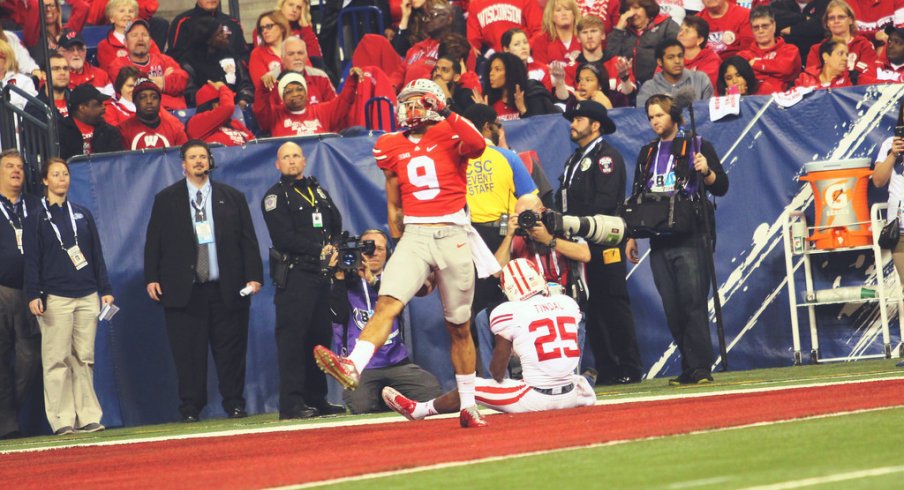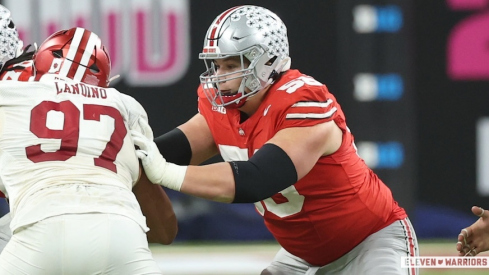The Ohio State Buckeyes turned in one of the most dominant performances in school history in dismantling Wisconsin in the Big Ten Championship.
The Buckeyes pitched the perfect game. Nearly every position group -- from the offensive line, to the defensive line, to the wide receivers -- turned in their season's best performance. And Cardale Jones exceeded all expectations with his decision-making and accuracy in the pass game.
With their spot secured in the college playoff, Ohio State must build upon its victory over the Badgers to face Alabama in the college football playoff semifinal.
Hit 'Em Short, Hit 'Em Long
Wisconsin introduced a wrinkle to their aggressive 3-4 defense. Rather than align in their base defense, the Badgers introduced a six man front with two down linemen.
Before the snap, one Wisconsin safety would come down and provide a seventh box defender against the run. The Badgers would then generally play cover 1 man or cover 3 defense behind the front.

Urban Meyer and Tom Herman's game plan in response was simple. The primary focus was exploiting the Badgers' man coverage. Ohio State mainly utilized 11 personnel to keep Wisconsin's slot defender outside the box. Then, the Buckeyes relied primarily upon three pass patterns -- all designed to defeat man coverage:
- a hitch or comeback route
- three verticals -- at times in the form of a hitch and go
- and mesh crossing routes that resulted in a triangle stretch to one side of the field.
Playing off Tendencies
Meyer and Herman then worked match-ups to their favor. Most prominently they placed Devin Smith in the slot, matching him up in single coverage against a safety.
To gain this advantage, Meyer and Herman played off Ohio State's success using JT Barrett as a runner from empty backfields in short yardage. Prior to the snap, Ezekiel Elliot motioned to an outside receiver.
The empty backfield keyed Wisconsin to expect a quarterback run. And it placed Smith in the slot. To sell the play fake, Jones stepped forward to fake a run, then dropped back to hit Smith.
Wisconsin did not have the athletes in the secondary to both take away the comeback route and not get beat deep -- particularly when Jones has the arm strength to quickly deliver the football.
In the run game, the Buckeyes largely exploited the Badgers with two plays -- split zone and buck sweep.
Split zone -- where the offensive line blocks tight zone in conjunction with the tight end blocking the backside end man on the line of scrimmage -- has become more prominent for Ohio State in recent weeks. But against Wisconsin, Meyer and Herman likely featured the play for two reasons.
First, with man coverage, the tight end blocking across the line of scrimmage forces a secondary player to follow him -- and away from the hole. Second, the back block accounted for the outside linebacker. And it opened a cut-back lane against the oft-slanting Wisconsin front.
Buck sweep -- utilizing two pulling offensive linemen -- responded to Wisconsin's heavy inside run focus. By committing a safety into the box the Badgers' lost second level run support on the edge.
In the second half Wisconsin adjusted to a 4-3 stack look, which temporarily slowed the Buckeyes' -- particularly as Ohio State reduced their passing game with a large lead. But Wisconsin's base front allowed the Buckeyes to return to their tight zone play, which re-started the offense.
Slingin'
In the Meyer era one thing has remained constant. Opposing defenses commit extensive numbers against the run and dare Ohio State to beat them downfield.
When the Buckeyes are able to complete vertical passes they generally win comfortably, as teams cannot simultaneously defend the inside run, the horizontal edge and deep zones.
This was never more apparent than against Wisconsin. In fact, the Buckeyes were a more downfield passing team with Jones than with Barrett. As a coach recently stated to me, there are two ways to stretch the field -- one is with a running quarterback and the other is with a quarterback that can hit all the spots with his arm.
Jones' skill set requires more of the latter. As noted, Jones' arm strength allows him to throw vertical routes -- even off his back foot.
But it also opens up comeback routes, as a minor amount of cushion is enough for Jones to deliver the ball.
Once Ohio State was consistent in the passing game Saturday Wisconsin had little chance to defend both the run and the pass.
And Jones had ample help. The offensive line controlled the line of scrimmage. And the wide receivers played by far the best game of Meyer's tenure, making several catches on under or overthrown balls. For instance Mike Thomas made several difficult receptions -- including his diving catch on the game's first play from scrimmage that undoubtedly assisted Jones' early confidence.
And Smith should have perhaps been the player of the game. His combination of speed and strength at the point of the catch makes him an ever-present vertical threat. When he makes plays down field Ohio State is very difficult to defend, evidenced by the Buckeyes' 21-0 record when he catches a touchdown.
Cleaning up
The one area where Jones struggled was his reads in the run game. Several times in the first quarter Jones unnecessarily kept. And although Jones is a run threat going north and south -- particularly when he scrambles -- he lacks the lateral quickness to be particularly effective keeping off the zone read. As a result, it appears that Herman and Meyer subsequently instructed Jones to give unless absolutely necessary.
But the Buckeye run game was buoyed by the offensive line and Ezekiel Elliot. On multiple explosive runs, Elliot was untouched until the second level due to the offensive line controlling the line of scrimmage.
And Elliot likely played the best game of his young career. He is unique in that he not only possesses ample speed but embraces contact. As important as his explosive runs he picked up several third and mediums by running through would-be tacklers and gaining yards after contact.
Between the Lines
But with all due respect to the offensive performance, the Buckeyes were able to dominate the game because the defense dismantled the Wisconsin run game.
Defensive Coordinators Chris Ash and Luke Fickell were previously reticent to move away from their base 4-3 over, cover 4 to move additional defenders into the box against the run. But any such hesitancy was gone Saturday.
In its place were several changes. The Buckeyes moved to a 4-3 stack, which placed outside linebacker Darron Lee in the box.
In the secondary, Ohio State used cover 1 man over. This meant that when Wisconsin was in an I-twins formation, the backside corner came across the formation to cover the second wide receiver.
And when the Badgers sent a receiver in motion the Buckeyes inverted their safety and corner. The corner would drop into the deep middle while the safety would come up in edge support.
These coverage adaptions permitted one safety to effectively function as an edge Sam linebacker. So in essence, against 21 personnel the Buckeyes operated from a 5-3 stack.

Ohio State would then revert to their base cover 4 when Wisconsin utilized 11 personnel.
Bringing a safety into the box not only provided an additional defender against the run. It also provided the Buckeyes' force support.
In so doing, the Ohio State defensive ends were freed from maintaining contain. Joey Bosa and the combination of Rashad Frazier and Steve Miller could squeeze down against down blocks, forcing the play to spill to the second level.
And as Kyle detailed, it was the Buckeye defense's dominance up-front that limited the Wisconsin run game. Michael Bennett, Adolphus Washington, and Bosa combined for 13 tackles. And ten of Melvin Gordon's runs resulted in zero or negative yards. The Buckeye defensive line consistently gained penetration and re-set the line of scrimmage.
Yet unlike lapses in previous weeks, the front four was able to do so while maintaining their gap integrity. From there, rather than read and fill holes, the Buckeye linebackers immediately came downhill and took on blockers in the hole to create a pile. The goal was to create a wall. Once Gordon had nowhere to run the Buckeye defenders then disengaged their blockers to make the tackle.
Bosa and Bennett were the best players on the field and dominated the contest. But equally as excellent was Frazier. Healthy after overcoming a nagging injury, he also consistently spilled the run and create pressure.
Darron Lee also played a prominent role. He repeatedly set the edge and then disengaged to make tackles. And when plays went away he is quick enough to shoot underneath and make plays from behind.
And the Buckeye secondary was sound in their tackling, particularly by corners Doran Grant and Eli Apple. The result was that Gordon -- Wisconsin's primary big play threat -- had zero explosive runs.
Once forced to pass, the Badger receivers could not create separation against Ohio State defenders. The Buckeyes blitzed less extensively than in recent weeks. Instead, Ohio State generally employed a four man rush, mixing man coverage with quarters and cover 3. Yet the Buckeyes defensive line still created pressure.
Putting it Together
In sum, Ohio State put together a complete effort. From winning the turnover battle 4-0, to creating explosive plays, to tilting field position with several punts from Cameron Johnson that pinned Wisconsin inside their ten yard line, the Buckeyes excelled in every facet of the game.
Now Ohio State must turn their attention to Alabama's balanced offense and stifling run defense -- something we will examine in the coming weeks. But before turning to the Crimson Tide, the Buckeyes should enjoy just how impressive of a performance they put forward on Saturday. Despite losing Braxton Miller and J.T. Barrett -- not to mention Noah Spence and Dontre Wilson -- this season, the Buckeyes beat a top 15 team 59-0 and earned a place in the college football championship. Put that way, 2014 likely has to be the best coaching performance of Urban Meyer's career.


